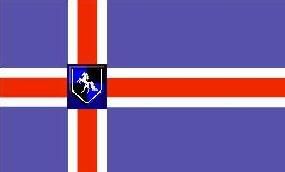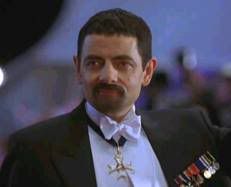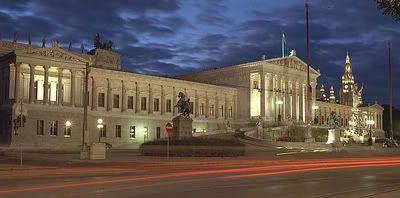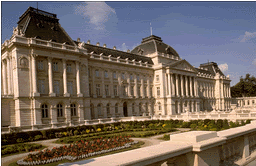Difference between revisions of "Arendaal"
m (Euro-Categorized) |
|||
| Line 381: | Line 381: | ||
arable land: 27% | arable land: 27% | ||
forests and woodland: 48% | forests and woodland: 48% | ||
| + | |||
| + | |||
| + | [[Category:Europe]] | ||
Revision as of 18:14, 7 July 2005

| |
| Flag of Arendaal | |
| Motto: Den største plikt av en Herskeren var å forsikre lykken av sinne Folket | |
| My Map | |
| Region | Europe |
|---|---|
| Capital | Emyn Arnen |
| Official Language(s) | Aren, English |
| Leader | Chancellor Pieter von Larscröna & King Edvard V |
| Population | +1.4 billion |
| Currency | Reath |
| NS Sunset XML | |
Contents
Kongeriket Arendäl
Arendaal is a liberal, democratic, Scandinavian Constitutional Monarchy. It lies in Western Europe, to the South of Kelas, the West of Formossa and Kirrengrad and North of Helvetic Confederation. It was established in 810 A.D by King Gustav I.
A nation very much open to immigration, Arendaal prides itself on tolerance and striving towards excellence in every regard. It is well known for it’s lavish lifestyle and overwhelming beauty in all aspects - beautiful people, landscapes, artistic achievements and architecture. It’s generous social security and welfare system, supported by the large revenues generated by it’s oil and natural gas reserves, allow for one of the highest living standards in Europe.
The Aren people enjoy the very highest standards of education and health care - all provided for free - and ample political & social freedoms.
For more information please visit: Arendaal's Webpage
Fact File
To provide a general idea of what Arendaal is like and how it functions, please view these following sections. They are intended to provide an overview of the nation's geographic, political, social and economic dimensions.
General Info
Country name:
conventional long form: Constitutional Monarchy of Arendaal
conventional short form: Arendaal
local long form: Kongeriket Arendäl
local short form: Arendäl
Data code: AR
Government type: Constitutional Monarchy
National capital: Emyn Arnen
Administrative divisions: 7 provinces (fylker, singular—fylke); Norseberg, Stockholm, Fjordholm, Rosekilde, Finnberg, Krystallberg, Icelandic Territories/Icenti
Provincial Capitals: Emyn Arnen (Norseberg), Trondheim (Stockholm), Helsindor (Fjordholm), Nareath (Rosekilde), Kronstad (Finnberg), Thorvald (Krystallberg), Rakverje (Icenti)
Nationality: noun: Aren (plural: Aren) ; adjective: Aren
Ethnic groups: diverse; mostly Germanic (Nordic, Alpine, Baltic), Lapps (Sami), Korean, various others
Religions: Evangelical Lutheran 38 %, other Protestant and Roman Catholic 12%, other 11%, none 39%,
Languages: Aren & English (both official) Norse, German, Norwegian, Dutch and French also spoken [Finnish, Lapp, Korean, Turkish, Hebrew, Russian, Urdu and Mandarin speaking minorities also prominent]
National Animal: The Stallion
National Flower: The White Rose
National Tree: The Norse Pine
National Sport: Skiing (due to Arendaal's distinctive landscape and abundance of snow in the winter)
National Anthem: "Av der Gladen" (to the tune of Beethoven's "Ode to Joy")
Gladen, skjønne Götterfunken,
Datter av Elysium,
Vir bryddetten feuertrunken,
Himmelske, din Heiligtum!
Dinne Dellig bandsjna aftur,
det som Moten barsk geteilt:
Alle Folke vorden Brødre,
der din sanfter Flügel weilt!
Ert verölden, Millijónen!
Denne Kuss den allen Velt!
Brødre, grensel Sternenzelt
mått en helser Vater vohnt.
Dinne Dellig bandsjna aftur,
det som Moten barsk geteilt:
Alle Folke vorden Brødre,
der din sanfter Flügel weilt!
Flags

The National flag of Arendaal is blue as the sky with a snow-white cross, and a fiery-red cross inside the white cross. The ‘seal’ on the flag, featuring a stallion shield, is the National coat of Arms, and was originally the flag of King Gustav I of Arendaal since 810. Blue represents lakes and sky, and white represents both the snow of the winter and the white nights of the Northern Aren summer. The red is now taken to represent the fjords and ocean, and the black, the night sky.
The cross on the Aren flag is technically a Christian Cross, as par the tradition of the Nordic countries, and was introduced after 1250 when Arendaal was made into a Christian country. In 1817, however, when the nation became a secular state, King Karl II chose to add the 810 seal of Gustavus to the middle of the cross, thereby changing its meaning from a Christian symbol to one of the multiple religions (Gustav had, obviously, been a pagan) and of multiple cultures in and of Arendaal. The flag has not undergone any major alterations since 1817.
Government

Ceremonial Chief of State: King Edvard V (since 1974)
Heir Apparent: Crown Prince Hans Matthias IV
Head of Government: Chancellor Pieter von Larscröna
The Chancellor is the head of government and, as such, the political leader of the country. Citizens elect the Parliament (Stortinget), which in turn picks the Chancellor. Elections are held every four years, but there is no limit set on how many times one individual may hold the office.
Ceremonial and Administrative Head of Government: President Dr. Friederick Helmgaard
The President performs largely ceremonial and administrative functions, and represents the nation from above the partisan fray. He signs laws into power, and is appointed by the National Senate (Riksrådet) with the approval of Parliament.
Cabinet: Made up of the Chancellor and National Ministers, and chaired by the Chancellor. This state council is ceremonially appointed by the President after approval from the Parliment. Members of the cabinet are overwhelmingly drawn from the Parliament and retain their Parliamentary seats while serving as ministers. The constitution maintains that ministers conduct the affairs of their ministries autonomously and with full responsibility, within the guidelines set by the chancellor.
Political System
Suffrage: 18 years of age; universal
Constitution: 1817, modified in 1884 and 1964
Every Aren citizen has an "active" and a "passive" franchise. The active franchise - ie: the right to vote - allows each adult citizen two votes. One is cast for a party at the national level, and a second is cast independantly - and possibly for a different party at the provincial level. Accordingly, Aren citizens elect members of National Parliament and of Provincial Parliaments directly. Since the provincial representatives that make up the National "Senate" or "Upper House" are members of provincial parliament they too are elected by the people.
The "passive" franchise - ie: the right to hold office - is afforded to all Aren citizens over 18 years of age regardless of place of birth, gender, sexual preference and monetary assets.
Stortinget: The National Parliament (Stortinget) is the chief repository of political power as delegated directly by Aren citizens through their votes. Six parties are represented in the current Parliament: two in the governing coalition and four in opposition. In addition to its legislative functions, it serves as a check upon the power of the executive. Arendaal has various systems of checks and balances to prevent concentration of power in the central government, an individual or a single group.

Riksrådet: The 'upper house' or 'national council' ("federal council") is the representation of the 7 provinces (fylker) of Arendaal. It is accordingly composed of delegates from the provincial governments. Seats are alotted to provinces in accordance with the population of that province, yet articles in the Constitution of Arendaal ensure that the smaller provinces receive a great deal of representation per inhabitant. In contrast to many other legislative bodies, the provincial delegates to the Riksrådet are required to vote as a bloc and represent the position of the provincial government.

Economy
Currency: Reath
Exhange Rate: 1 Reath : 1 Euro
GDP: purchasing power parity: $209.68 billion
GDP-real growth rate: 12.5%
GDP-per capita: purchasing power parity: $87,300
GDP-composition by sector: agriculture: 3% industry: 34% services:63 %
Inflation rate-consumer price index: 2%
Labor force:
total: 2.13 million
by occupation: services 51.86%, industry 42%, agriculture, forestry, and fishing 7%
Unemployment rate: 0.14%
Budget:
revenues: $258 billion
expenditures: $127 billion, including capital expenditures
Industries: Oil, petroleum and natural gas, banking system, automobile manufacturing, diamond production and cutting, shipbuilding, timber, textiles, mining, metals, chemicals, pulp and paper products, fishing, food processing, book publishing, luxury goods and gambling.
Society
Age structure:
0-14 years: 20%
15-64 years: 65%
65 years and over: 15%
Sex ratio:
at birth: 1.6 male(s)/female
under 15 years: 1.6 male(s)/female
15-64 years: 1.4 male(s)/female
65 years and over: 0.8 male(s)/female
Population growth rate: 0.41%
Birth rate: 13/1,000 population
Death rate: 14 /1,000 population
Net migration rate: 4.1 migrant(s)/1,000 population
Infant mortality rate: 5 deaths/1,000 live births
Life expectancy at birth:
total population: 78.23 years
male: 75.42 years
female: 81.21 years
Total fertility rate: 1.3 children born/woman
Literacy: definition: age 16 and over can read and write
total population: 99.8 %
Note: The standards of Aren education are exceptionally high. The three highest ranked universities in Arendaal are located in Emyn Arnen, Helsindor and Kronstad, respectively.
Aren Language
The two main official languages of Arendaal are English and Aren, with all citizens proficient in both.
The native Aren language derives from the Germanic dialects of Nordic descent intergrated with elements of Latinate vocabulary. To better illustrate the language, here are some basic phrases in Aren provided with English translation.
Vilkommen … welcome
Hallo … Hello
vær så … bye
Gut morgen … Good morning
Guttag … Good day
Gut kväll … Good evening
Gut nacht ... Good night
Ja … yes
Nein … no
Bitte … please
Takk … thank you
Tusen takk … Thank you very much
ingva årsak … you’re welcome
Unskyulldig … excuse me
Berklager … Sorry
Ursäkta mir! … Forgive me
Ingen orsak … It's all right
Kann du hielfe mir? … can you help me?
Snaekkvar du Engelska? … Do you speak English?
Berklager, jeg snaekkvar ikkje Norskarnen … I'm sorry, I don't speak Arnen
Jeg forstår ikkje … I don’t understand
Mitt navn es ... My name is ...
Hyggelig å treffe dieg … pleased to meet you
Hva heter du? … What is your name?
Hvorden var du dyet? … how are you
Ver, takk … Good, thank you
Nyheter … today
Nästa dag … next day
Nästa vecka … next week
Hvor es? … where is it?
vent litt … wait a moment
Rökning skyulden … No smoking (i.e.: Forbidden smoking)
Jeg vil … I’d like…
Får jag me om ... Bitte? … Could I have..., please?
Var kann ich anrufen? … Where can I make a phone call?
Var kann ich finna en taxi? … Where can I find a taxi?
Havst du Tine?... Do you have fire (ie: a lighter)
Geography
South of Kelas , west of Formossa and Kirrengrad and north of Helvetic Confederation
The coastline, 1,700 miles (2,740 km) long, is fringed with and is deeply indented by numerous fjords. From the coast the land rises sharply to high plateau. The highest peak rises up to 3,472 m, west of which lies perhaps the largest glacier field in Europe. The mountains and plateaus are intersected by fertile valleys, and by rapid rivers, which furnish hydroelectric power and are used for logging. Because of the North Atlantic Drift, the nation has a mild climate for a northern country, although winters are long and cold particularly in the extreme east (particularly due to its high elevation). Most of the population is concentrated along the western coast and in the nation's valleys, where most chief cities are located. The eastern borders are lined with high mountains.
Climate: temperate along coast, modified by North Atlantic Current; colder interior; rainy year-round
Environment—current issues: acid rain damaging forests, adversely affecting lakes and threatening fish stocks
Geography—note: about two-thirds mountains; some 1000 small islands off its much indented coastline; strategic location adjacent to sea lanes and air; one of most rugged and longest coastlines in the world.
Coastline: 21,925 km (includes mainland 5,419 km, islands 413 km, long fjords, and minor indentations 16,093 km)
Terrain: glaciated; mostly high plateaus and rugged mountains broken by fertile valleys; small, scattered plains; coastline deeply indented by fjords; arctic tundra in north; 5 main rivers which branch out into several smaller rivers. Most cities are located on or near a major river.
Elevation extremes:
lowest point: 0 m
highest point: 3,472 m (Mt. Blanc)
Natural resources: petroleum, oil, silver, platinum, diamonds, copper, natural gas, pyrites, nickel, steel, iron ore, zinc, lead, fish, timber, hydropower
Land use:
arable land: 27%
forests and woodland: 48%
